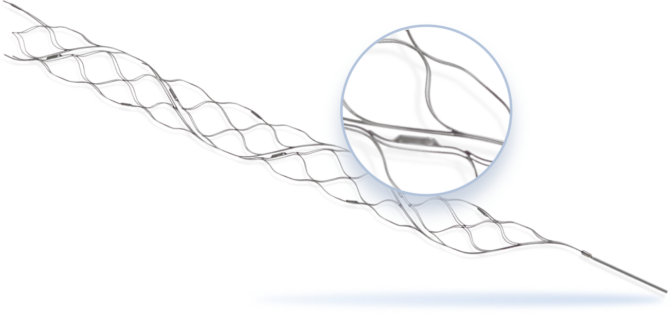ENVI™-SR
CE marked product information
Intended Use
The ENVI™-SR is intended for use to restore blood flow in the neurovasculature by removing thrombus in patients experiencing ischemic stroke within 8 hours of symptom onset. Patients who are ineligible for IV tPA or who fail IV tPA therapy are candidates for treatment.
Contraindications
Use of the ENVI™-SR is contraindicated under these circumstances:
- Patients with known hypersensitivity to nickel-titanium.
- Patients with angiographic evidence of carotid dissection.
Warnings
- Do not use if damage to the device is observed.
- Do not use if the product sterile barrier system or its packaging is compromised.
- Do not resterilize and/or re-use in multiple patients. Structural integrity, sterility and/or function may be impaired by resterilization or re-use.
- To reduce risk of device damage, vessel damage, and/or patient injury:
- Select the appropriate ENVI™-SR based on the vessel size to be revascularized.
- Do not perform more than 3 revascularization attempts in the same vessel.
- Do not deliver and retrieve the ENVI™-SR more than 3 times.
- Do not torque the ENVI™-SR.
- Monitor ENVI™-SR positioning in vessel during exchange to prevent movement.
- Do not pull the ENVI™-SR through a pre-existing stent or entanglement and vessel damage may occur.
Precautions
- Carefully read these directions before using this product. Observe warning and safety precautions.
- For each new Retriever, use a new microcatheter.
- The appropriate anti-platelet and anti-coagulation therapy should be administered in accordance with standard medical practice.
- The ENVI™-SR should only be used by physicians experienced in angiographic and percutaneous neurointerventional procedures.
- Use device prior to “Use-by” date printed on label.
- Prevent exposure to temperatures in excess of 60°C. Exposure to temperatures above this temperature may damage device and accessories. Do not autoclave.
- To prevent thrombus formation and contrast media crystal formation, maintain a constant infusion of appropriate flush solution between guide catheter and microcatheter and between the microcatheter and the Retriever or guidewire.
- Caution: Federal (USA) law restricts this device to sale, distribution and use by or on the order of a physician.
Potential Complications
Possible complications of the use of the ENVI™-SR include, but are not limited to:
- Adverse reaction to antiplatelet/anticoagulation agents or contrast media
- Air embolism
- Arteriovenous fistula
- Change in mental status
- Death
- Device deformation, collapse, fracture, or malfunction
- Distal embolization including to a previously uninvolved territory
- Hematoma and hemorrhage at puncture site
- Infection
- Intracranial hemorrhage
- Ischemia
- Neurological deficits
- Neurological deterioration including stroke and death
- Perforation or dissection of vessel
- Post procedural bleeding
- Pseudo aneurysm formation
- Thrombosis
- Vascular occlusion
- Vessel spasm




